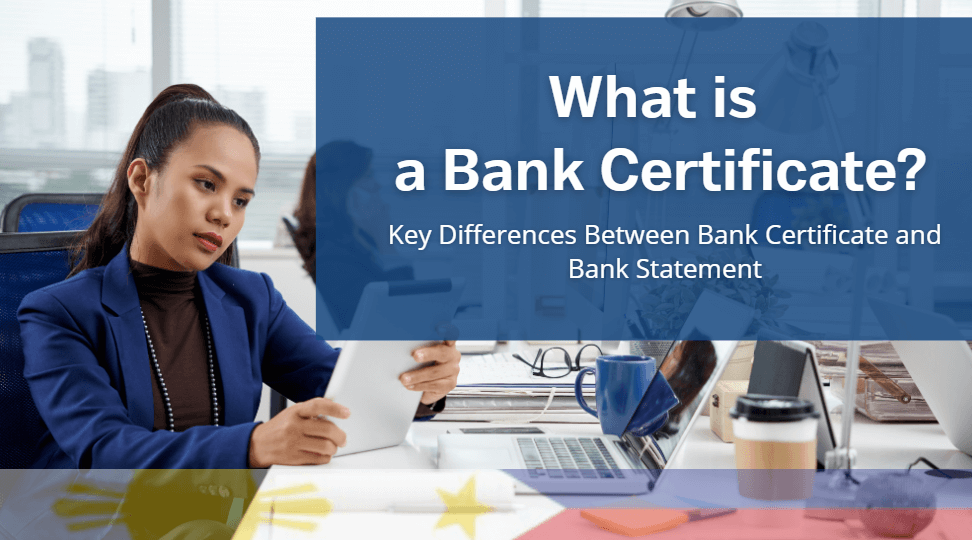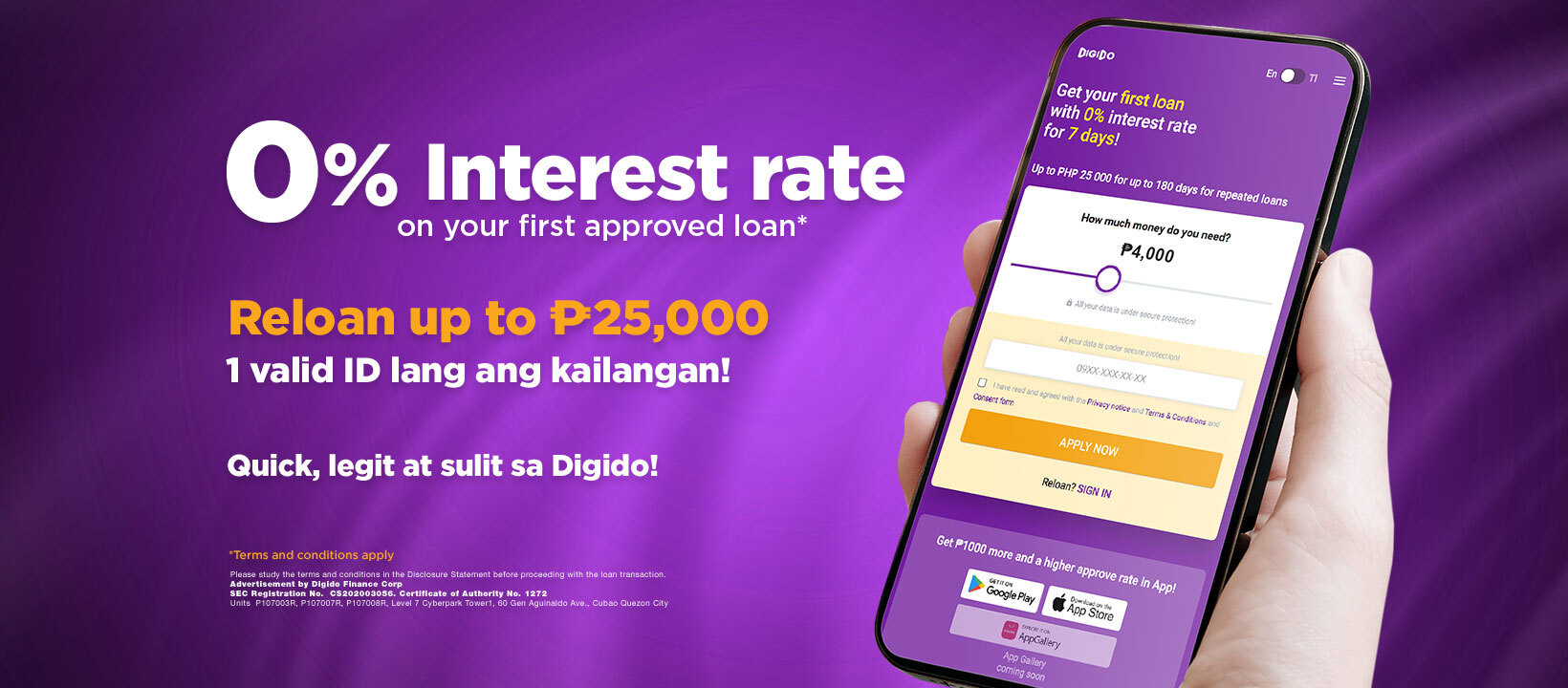What is a Bank Certificate: How to Request one, Difference with a Bank Statement
Key takeaways:
- A Bank Certificate is used as proof of funds, showing an individual’s account balance and type
- Unlike bank statements, a bank certificate is a snapshot in time and does not specify transactions or movement of funds
- Bank certificates typically have security features such as official seals, watermarks, and signatures to prevent forgery
Table of Contents

A bank certificate is an official document issued by banks that verifies an account holder’s details and current balance. Whether for international travel, securing loans, or regulatory compliance, knowing how to access and utilize this document can streamline various financial processes. In this guide, we’ll cover what a bank certificate typically includes, how to request one, and how it differs from a bank statement.
What is a Bank Certificate
A Bank Certificate in the Philippines is a formal document issued by a bank that attests to the account details and balance of a depositor at a specific point in time. This document serves as proof of the depositor’s relationship with the bank and is often used for various official and legal purposes such as visa applications, loan applications, and regulatory compliance.
A bank certificate is a document provided by your bank that certifies the existence of your account and shows your current balance and other specific details.
A typical Bank Certificate will include the following information:
- Bank Name and Branch: The official name and address of the issuing bank branch.
- Date of Issue: The exact date on which the certificate is issued.
- Account Holder’s Name: The full name of the account holder as registered in bank records.
- Account Number: The specific account number associated with the account holder.
- Account Type: Whether the account is a savings, checking, or any other type of account.
- Current Balance: The total amount of money in the account at the time the certificate is issued.
- Average Balance (if applicable): Some certificates may also include the average balance over a specified period.
- Account Opening Date: The date on which the account was originally opened.
- Bank Seal and Signature: A signature by a bank officer and an official bank seal to authenticate the certificate.
Banks issue this certificate upon the request of an account holder, often for a fee. To obtain a bank certificate, the account holder must typically visit their bank branch in person, fill out a request form, and pay the applicable fees. The process can usually be completed within a few days, depending on the bank’s procedures.
Bank Certificate Validity
For most practical purposes, a Bank Certificate is considered valid for a short period after issuance. The common timeframe for which it is considered valid can range from one to three months. This period reflects the fact that the financial information it certifies—such as account balance and status—is subject to change as new transactions are made.
- First loan with 0% interest rate
- Only 1 valid ID needed to Apply

Learn more: How to Get
✦ Loans for Self-Employed
✦ Online Loan No Requirements in the Philippines
Why do you need a Bank Certificate
A Bank Certificate is needed for several reasons, primarily because it serves as an official and reliable confirmation of a depositor’s banking status and balance at a particular moment. Here are some common purposes for which a Bank Certificate is necessary:
- Visa Applications
Many countries require proof of financial stability from visa applicants to ensure they have sufficient funds to support themselves during their visit. A Bank Certificate can serve as evidence that the applicant has a stable financial background.
- Loan Applications
Financial institutions often require proof that the applicant has the financial stability and liquidity to meet loan repayment obligations. A Bank Certificate provides a snapshot of the applicant’s current financial status, aiding lenders in their decision-making process.
- Business Registration and Compliance
When registering a new business or complying with certain regulatory requirements, entities might need to show proof of capital or financial standing. A Bank Certificate can fulfill these requirements, proving that the business has the necessary funds in place.
- Proof of Assets in Legal Situations
In legal proceedings such as divorce, inheritance disputes, or other court cases, a Bank Certificate may be required to establish the financial position of an individual or entity.
- Real Estate Transactions
When buying property, especially in high-value transactions, a Bank Certificate can be used to prove the buyer’s financial capability, which can be a critical factor in the transaction’s approval.
- Foreign Exchange and Large Transactions
For large transactions or when dealing with foreign exchange, financial institutions might require a Bank Certificate to comply with anti-money laundering regulations and to ensure that the account holder has the financial capacity to complete the transaction.
- Securing Business Contracts
Companies may be required to present a Bank Certificate when entering into large contracts, particularly with government entities, to demonstrate financial reliability and operational stability.

Bank Certificate vs Bank Statement
Understanding the differences between a Bank Certificate and a Bank Statement is essential for managing financial documentation effectively, as each serves distinct purposes and provides different types of information.
Above you have learned what Bank Certificate is and what it is for, now let’s learn what Bank Statement is and compare the two.
A Bank Statement is a detailed record issued by a bank that lists all transactions in an account over a specific period, usually monthly. It reflects the account’s activity, including deposits, withdrawals, and other financial transactions.
It typically includes:
- Account holder’s name and address
- Account number
- Period of statement
- Opening and closing balance
- Detailed list of all transactions (dates, descriptions, amounts, etc.)
Bank Statements are used for:
✅ Regular financial monitoring and management
✅ Preparing financial statements or tax returns
✅ Verifying account activity (e.g., checking for unauthorized transactions)
✅ Supporting documentation for loans and mortgages
Thus, the Bank Statements provides a comprehensive view of an account’s activity over a set period. It is regularly sent to account holders or can be accessed through online banking services.

Key Differences Between Bank Certificate and Bank Statement
Scope of Information: A Bank Certificate provides a static certification of an account’s status at one point in time, while a Bank Statement offers a dynamic, detailed record of all transactions within a specified period.
Purpose of Use: Bank Certificates are typically used when formal verification of account status and balance is required, without revealing transaction details. Bank Statements are used for a detailed understanding and tracking of financial transactions.
Regular Issuance: Bank Statements are regularly issued (often monthly), whereas Bank Certificates are issued on request.
Thus, choosing between a Bank Certificate and a Bank Statement depends on the specific need: whether you require a formal certification of your financial status at a moment in time or detailed tracking and record-keeping of your account’s transactions.
Learn more:
✦ Credit Card Amnesty Program in the Philippines
✦ SSS Bank Enrollment Guide
Bank Certificate Requirements in the Philippines
To request a Bank Certificate in the Philippines in 2024, you will generally need to provide the following:
✅ You must present a valid government-issued ID, such as a passport, driver’s license, or UMID, to verify your identity.
✅ You should know your bank account number and the type of account you are requesting the certificate for.
✅ Be prepared to specify the reason for the request, which could be for visa applications, loan approvals, or other legal and financial matters.
✅ There is typically a fee for issuing a bank certificate. This fee varies by bank but must be paid at the time of the request. The fee can usually be paid either in cash or directly debited from your account.
The process involves visiting your bank branch, completing a request form with your account information and the details mentioned above, and submitting it along with your ID. Processing times can vary; some banks offer same-day issuance, while others may require a return visit to collect the document.

How to Request Bank Certificate from a Bank branch
Requesting a Bank Certificate from a physical bank branch in the Philippines involves several straightforward steps. Here’s a general guide on how to request this document:
- Step 1: Visit Your Bank Branch
Go to the branch where you opened your account or any branch of your bank. If possible, visiting the home branch (where the account was opened) can sometimes make the process smoother.
- Step 2: Fill Out a Request Form
Upon arrival, ask the bank teller for a Bank Certificate request form. Fill in the necessary details such as your account number, name on the account, and the specifics of what you need on the certificate.
Specify Details: If you need specific details included (e.g., average balance over a certain period), mention this to the bank officer.
- Step 3: Pay the Fee
Most banks charge a fee for issuing a Bank Certificate. The fee can vary from bank to bank, so it’s good to be prepared for this expense. Fees are generally reasonable and can be paid directly at the bank.
- Step 4: Processing Time
Some banks can issue it on the same day, while others might take a few business days. It’s best to ask about the expected wait time when you submit your request.
- Step 5: Collection
You may be required to collect the Bank Certificate in person. In some cases, banks can also send it to your registered address or make it available for secure download through their online banking platform, if they provide digital certificates.
It might save time to call your bank ahead of your visit to check on specific requirements or if you can start the process over the phone or online.
Need Cash Fast? Borrow up to PHP 25,000 with just 1 government valid ID. Calculate your pre-approved loan amount with Digido calculator:
* Interest payments are approximate. The final loan amount and interest rate must be confirmed in your loan agreement after loan approval.
How to Get a Bank Certificate Online
To get a Bank Certificate online from digital banks in the Philippines, you typically follow a streamlined process within the bank’s app or website. These processes are designed to be quick and user-friendly, reflecting the digital-first approach of these banks.
Here’s a general outline of the steps you might take with most digital banks:
- Log into the Digital Banking App: You need to log into your account on the bank’s mobile app or website.
Navigate to Account Services: Look for the section on your app or online profile where you can manage your accounts. This is often labeled something like “Accounts,” “My Savings,” or “Account Services.” - Request a Bank Certificate: There should be an option to “Request Bank Certificate” or something similar. You may need to select the account for which you need the certificate.
- Specify the Purpose: You often need to specify the purpose of the request (e.g., visa application, loan application, business requirements). Some banks allow you to customize the details that appear on the certificate.
- Confirm and Submit the Request: Fill in any required information and confirm the details. Some banks might require you to enter a One Time PIN (OTP) sent to your registered mobile number to verify the transaction.
- Download the Certificate: Once processed, you can typically download the certificate directly from the app or receive it via email. Some banks allow instant download, while others might take a business day.

For instance, CIMB Bank users can request and download their bank certificate directly from the app by navigating to the account details section and selecting the certificate request option. Similarly, users of the Tonik and Maya apps can request a bank certificate from their user profile or savings menu and receive it via email or download it directly.
If you’re looking for a bank certificate sample, most banks provide examples or details on what their specific bank certificates look like directly on their websites. These samples often illustrate what kind of information the certificate contains. You can usually find these samples in the customer service or FAQ sections of your bank’s website.
Conclusion
When applying for a loan, such as for buying a house and lot in the Philippines, you’ll often need to provide a bank certificate or a bank statement. It’s important not to confuse these two documents, as they serve distinct purposes and contain different information.
If you are requested to provide either of these documents, make sure to request the correct one based on the requirement’s purpose.
Learn more about:
✦ 20 Profitable Small Businesses you can Start in the Philippines
✦ 25 Best Side Hustles in the Philippines
Additional FAQs about Bank Certificates and Bank Statement
-
What is the Processing Fee for a Bank Certificate?The fee for a bank certificate can vary by bank but generally ranges from PHP 100 to PHP 500
-
Does the standard bank certificate include details of the subsidy or grant?No, a standard Bank Certificate in the Philippines does not typically include details about specific transactions, such as receiving subsidies, grants, or other specific deposits. It primarily serves as a snapshot of the account balance and status at the time of issuance
-
Where can I get information about subsidies or grants?If you require documentation that shows specific transactions, such as the receipt of a subsidy or a grant, you would need a bank statement rather than a bank certificate.
-
What information does a bank statement contain?A bank statement provides a detailed record of all transactions occurring over a period of time, including deposits, withdrawals, and other financial activities.
-
How to get a bank statement?To obtain a bank statement, you can usually request it directly through your bank's online banking platform, at an ATM, or by visiting a branch in person, depending on the bank's services and your preferences.



